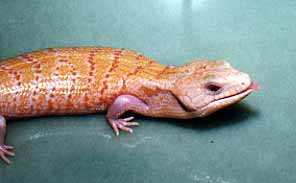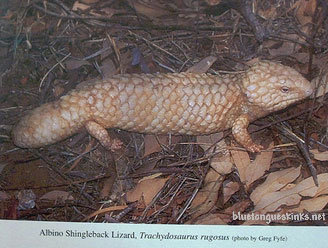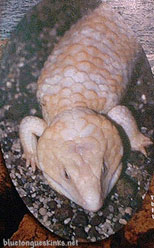|
Introduction
- Albino - "A person or animal lacking normal pigmentation, with the result being that the skin and hair are abnormally white or milky and the eyes have a pink or blue iris and a deep-red pupil."
- Albinism - "Congenital absence of any pigmentation or coloration in a person, animal, or plant, resulting in white hair and pink eyes in mammals."
Once in a great while, an ALBINO blue tongue skink is born with the litter. It's a rarity, a treat, and a sight to behold. It's really no different than the white tiger, and many other animals. It's just a freak thing that happens once in a whileó Breed two 'blue' tongues, and once in a 'blue' moon, you may receive the highly coveted snow white albino blue tongue appropriately nicknamed: "The Blizzard Lizard". Theoretically, unlike snakes, the breeding of an albino blue tongue skink has never been successfully accomplished. This is mostly in part due to their extreme rareness and unavailability. Their colors can vary from completely white, to faint yellow and orange stripes. The eyes are also cloudy & reddish. Some argue that the unofficial term 'Blizzard Lizard' only refers to a lizard that is completely white, and albino only pertains to those that have the faint yellowish stripes (and/or lack of pigmentation). Blue tongue skink albinos have PINK tongues.
The following text is written by James Wilson
|
|
Albinism vs. Amelanism
True albinism is a recessive genetic mutation in which the affected animal has a total lack of all pigmentation on its entire body, including the eyes, causing the irises to be red or pink. Many people confuse albinism with amelanism, which is where the affected animal has a total lack of all melanin (dark pigment) and red or pink eyes. Most mammals, including humans, have only one pigment (melanin) present, and for them, there is no different between albinism and amelanism. However, most reptiles possess other pigments such as xanthin (yellow) and etherin (red) which still play a major role in the reptile's coloration, even when there is no melanin present, as is the case with amelanism. While turning up occasionally in Australia, I do not currently know of any albino Blue-tongued Skinks here in the U.S. However, I do know of a group of albino Indonesian Blue-tongued Skinks (Tiliqua gigas) that were sold by an east coast reptile dealer, to a reclusive breeder in the San Francisco area, a few years ago. They are pictured on page 84 in the German book ďAlbinos, Color and pattern mutations of snakes and other reptilesĒ, by Stefan Broghammer. I went to great efforts to contact him, in order to get more information on this group, and he contacted me once. However, I have not heard from him since. I have some other photos of these animals that were taken by the individual that originally sold them, and they are quite interesting in that one of the skinks shown is a typical amelanistic specimen with lots of reds, yellows, oranges, and pinks, while the other is a true albino being white with very faint yellow markings (both specimens have red eyes). There are two photos of blue-tongues, with interesting color mutations, that are published in some of the popular herpetological magazines and books in this country. Only one of them is a true albino. It is an Eastern Blue-tongue (Tiliqua scincoides scincoides), and it was taken by Karl Switack at the Australian Reptile Park in (you guessed it) Australia. The other photo is of a young Irian Jaya Blue-tongued Skink (Tiliqua ssp.) that was taken by Dick Bartlett. This skink is actually not albino by the strictest of definitions. However, it is most probably amelanistic, but there are potential questions that could be raised in reference to its normal appearing eyes. Unfortunately, this specimen died not long after it was photographed. There is also an interesting photo of an albino Blotched Blue-tongued Skink (Tiliqua nigrolutea) that is pictured on Page 64 in the November, 2001 issue of Reptiles Magazine. The photo was taken in Tasmania, Australia by Author Ferguson of the Perth Zoo. The specimen is owned by a collector in the private sector (I do realize that that rhymes).
|
|
Hypomelanism
This term refers to an animal that displays reduced amounts of melanin, possessing smaller amounts than would the norm for its particular species. It is a very broad term covering everything from animals with recessive genetic mutations such as leucism, albinism, and amelanism, to animals that are a little lighter than usual with no apparent genetics responsible. There are some Blue-tongued Skink specimens that fall somewhere in between, showing a definite reduction in melanin, and appearing to display some sort of genetic abnormality. These are the blue-tongues that come to mind when we hear the term "Hypo." Weather this is a co-dominant or recessive trait remains a mystery at this time. These Skinks are quite rare and very expensive. They are the only "morph" that is available here in the U.S. today (with the possible exception of albinos). Some of these Hypos are more than you would expect them to be, while others are sadly disappointing. Because of the broadness of this term, it is advised to always get a photo of the specimen before you send off your life savings.
|
|
Leucism
This trait is displayed in animals that have no pigmentation, appearing milky white with bluish black eyes. I have heard more than one report from people claiming to have Leucistic Blue-tongued Skinks, and to date, none have even come close to being an actual leucistic Blue-tongue. As far as I know, Leucism has not yet been witnessed in Blue-tongued Skinks.
|
|
Melanism and Hypermelanism
Melanism refers to animals that are completely black or dark brown that would not display such coloration under normal circumstances. The term is often misused to describe animals that are merely darker than normal, but by no means solid black or dark brown. These darker animals are more correctly referred to as hypermelanistic. Melanistic Blue-tongued Skinks are non-existent in U.S. collections, and very rare in Australia, with only two reports of total melanism occurring in blue-tongues. The first was a newborn Eastern Blue-tongue (Tiliqua scincoides scincoides) from Sydney. The second is a Blotched Blue-tongue (Tiliqua nigrolutea) from Tasmania. While being extremely rare, it is no surprise that these two examples are both members of the two most southernly ranging Tiliqua species, whose range includes many highland regions and are therefore subjected to colder temperatures than the other members in their genus. There are populations of the Shingle-back Skink (Trachydosaurus rugosus), in the same area in New South Wales, that are almost entirely melanistic. Being melanistic, these skinks are able to absorb heat more efficiently when basking in a range where heat is hard to come by. It is possible that these two Melanistic blue-tongues could be a glimpse into the evolutionary future of the Tiliqua that inhabit these colder ranges.
|
|
Striped Blue Tongues
Could it actually be true? Apparently the answer is yes. There is a breeder in Ohio who had a striped Irian Jaya Blue-tongued Skink (Tiliqua ssp.) in his collection. It was a very light tan color with two thin brown stripes that run from the neck to the tip of the tail. As far as I know, it was the only one of its kind. It is also not known if it was a recessive or co-dominant trait, or if it was even genetically reproducible at all. I happen to think that it was genetically reproducible and most likely co-dominant, but that is purely speculation on my part. Unfortunately, it will remain a mystery, as the owner recently informed me that this animal died before its second year from unknown causes.
|
|
Fancy Names and Marketing Games
Some people like to classify every slightly different colored specimen into a "phase" or "race". This is okay if it is just left at that, but it always seems to snowball into some kind of insane game of marketing name one-up-man-ship. This has been going on for years now with the Bearded Dragon and now it has unfortunately reached the Blue-tongued Skink market. In the last few years I have seen Blue-tongued Skinks marketed as silver, yellow, cream, and multi-colored phases. Some of these descriptions have at least some basis, while others are simply obvious marketing ploys with no precedence. Now there are more recent terms such as pastel, citrus-hypo, and patternless-anerytheristic being coined by "breeders" who don't even seem to know the definitions of the terms they are using. These terms often contradict themselves, and are more often than not totally inaccurate. However, there are occasionally skinks from certain geographic locals that display a slight variation in color from the norm for that species, and will often breed true when bred with another specimen from the same local. With many of these skinks being from Australia, there is a problem with actually finding pure specimens that originate from any certain local as there has not really been any local specific breeding of the Australian blue-tongues in this country. There are currently efforts by breeders to gather some of these local-specific forms for breeding purposes. We have gathered over 100 Blue-tongued Skinks and have meticulously grouped them first according to species or subspecies, and second, according to color and form. There will not be any names given to any of these color forms, morphs, or phases until they are reproduced successfully. As with any other reptile purchase, I recommend viewing the actual skink, or at least a photo of the skink, so as to verify weather or not it lives up to its name or any other claims.
Text written by James Wilson
|
|
True Albinos
This first trio of pictures was taken by Johan Van den bergh in Australia this year. They are true Eastern albinos.
Johan:
"In February 2004, I paid a visit to the Australian Reptile Park in Gosford NSW to see an albino Eastern BTS. Turns out, they had more than one. Ever since a single albino was found in the wild near the park, the park gets phone-calls from people who find weird looking blue tongue skinks in the wild. They all seem to be found in the same area.
By now, the park has 3 or 4 albinos (the ones Iíve seen).
When I was there, they didnít have any on display. They were only showing one during a reptile discussion.
After the talk, I met John Weigel who is the director of the park, and he privately showed me some of the other albinos they have.
Sure enough, they all look the same, except one. All are pure white with pink-red markings, red eyes, and a pink tongue.
The other one is pure white, but without the markings; only a pinkish shade.
I donít know if there is a difference between the 2 forms. Are they both albino or is one form albino and the other one amelanistic?
One thing is sure, they all have the red eyes and the pink tongue.
As far as I know, the park hasnít bred pure albinos yet. They only have a litter from an albino male with a normal female. The babies turned out completely normal. The best way to tell if it IS genetic, is to breed the male to one of its female offspring."



This next set is submitted by James Wilson. The first photograph is an albino nigrolutea (blotched), and the second is a virtually unheard of melanistic nigrolutea. This is the animal that was talked about in the "Melanism and Hypermelanism" section.


An Indonesian...

This next set speaks for itself! A stunning true albino Shingleback. Thanks to Edward for scanning these images.
 
|
|
And a VERY special picture sent to us exclusively from The Gosford Reptile Park in Australia . . .
 ( click to enlarge )
( click to enlarge )
This picture may not be used without permission.

|
|
Albino Look-A-Likes
These first two pictures show Lissa, a very large Northern. James recently had her for sale, and she was just purchased by Alex Bendana. You may contact him, or James on the message board. Alex is planning to breed her with his male Northern, so stay updated on the forums! Lissa's 'whiteness' is attributed to an extremely rare genetic mutation, and is not true albino as we know it in the sense of the term. Here is a paragraph written by Alex explaining her condition and how it relates (and doesn't relate) to albinism. He believes Lissa has a genetic condition known in the snake world as "Tyrosinase positive albinism" or just "T-positive albinism".
1) "Classic" Tyrosinase negative albinism (red eyes, white skin)
In tyrosinase-negative albinism(also called amelanistic albinism), the congenital inactivity of the enzyme tyrosinase prevents the cellís use of tyrosine in the formation of the pigment melanin.
So in these animals the genetic defect renders them unable to produce tyrosinase at all.
2) Tyrosinase positive albinism (T-positive albinism)
In tyrosinase-positive albinism, tyrosinase activity is normal, but there is an inability of the cells to sequester the synthesized melanin into the melanosomes.
With t-positive albinism, because the animal can still produce tyrosinase, and therefor melanin, even though there is a defect in their cells ability to use the melanin, it is still being produced which correlates to a very, very small amount of melanin being deposited into certain areas of the tissue, usually the eyes.
It is actually very fascinating because if you think about it, we are talking about two COMPLETELY DIFFERENT genetic defects, with very similar results. With regular albinism, the gene defect is that the animal can't produce its own melanin. With t-positive albinism, the animal produces melanin just fine, but their gene defect doesn't allow the melanin they produce to enter their cells normally. So in reality these two genetic defects aren't even related at all, they just produce similar results.
From what I understand, both genetic defects are extremely rare in reptiles, with "classic" albinism being seen a bit more often than t-positive albinism. They easiest way to tell the two types apart is that an animal with classic albinism will be completely white with red eyes, since they can't produce melanin at all. T-positive albino reptiles will be almost completely white to completely white, and their eyes will usually be MUCH lighter than normal, from a orangy brown to greenish hue.
Lissa has all of the earmarks of a reptile with T-positive albinism. She is white with yellow eyes and has small creamy yellowish and beige deposits on some of her back.




Here are a couple of 'Silver Tanimbars'. Usually unique only to this species, the tanimbars often turn a silvery gray color with age.


Here is a unique white looking Shingleback.

A white Eastern. (Same animal)


Our white Eastern named 'Enzo'.

More pictures of Enzo
|
|
Summary
It is obviously very easy to brand any white skink an albino. Hopefully after reading this sheet, you've learned a little bit more about their history, their extreme rarity, their beauty, and how they should never be taken for granted. Even the pictures on this page are an exclusive and rare privilage. We hope you have enjoyed them. A special thanks to Johan Van den bergh, Gosford Park, and James Wilson.
Compiled by Zach @ bluetongueskinks.net
| |
 ģ
ģ
 ģ
ģ